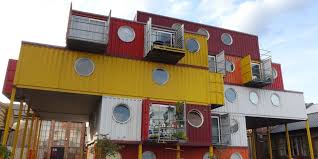There are, of course, the normal options that tend to come to mind. If there are motel rooms close to your property that rent by the week, this could be a good option if you can lock down a good rate. You could even do a home or apartment rental if you are lucky enough to find one with a month to month lease. That way, you're not locked into anything long-term. Now, if your build will take a bit longer, you may even want to look into a rent-to-own deal. There's no pressure to be out by a certain date, you can always sell it again once you're ready to move to your homestead, or you could retain ownership, and rent it out for an added source of income so long as you don't mind being a landlord.
But there are also other options available for rental purposes. If you are considering renting, these may be better if you want to be nearer to, or actually on your property. Not to mention, that if you have children of the 4-legged variety, it can be extremely difficult to find a traditional rental property- some areas, harder than others. But here are a couple of options that are much easier to secure, and they are pet friendly.
RV rentals are good for the very short term. While there are a few companies out there who do rentals, one that is nation-wide and has lots of options is here. They have different sizes available, they allow pets, and they let you choose how long you want your lease to be. Some of their packages do include mileage, as they are designed primarily for vacation purposes, and expect you to be doing a lot of driving. Much like a rental car company, they will let you return it to the place of the rental, or you can arrange a one-way trip. Now this can be a more costly option. Depending on the size of the RV, and how far you want to go, it averages out to roughly $700.00 - $1,000.00 a week. For me, knowing that my homestead will almost certainly take more than a month or two to complete, this option shoots way beyond my price range.
Then there are what are sometimes referred to as "homestead rentals". These are businesses that specifically provide rental accomodations for those who need a place to stay while building their homestead, as well as for any number of other reasons. They offer mobile homes, manufactured homes, travel trailers, converted containers, and cabins. They deliver the home directly to your property, and (generally) offer to hook it up to power, whether it be the grid, or alternative power. Their lease agreements are designed to work with the homesteader, most often at a year or less. Prices vary according to which type of shleter you're looking at and, in some cases, how catered you want it to be to your specific needs. For that reason, an exact price is hard to lock down without going in and filling out a form and/or speaking with someone directly. Now just for a point of fact, I have not done business with any of these companies, so I cannot speak to their reliability or quality. I will tell you, from what research I have done, I haven't found anything - good or bad - with the Better Business Bureau. And there are both good and bad reviews in various discussion forums. I suppose it depends on exactly what you are looking for and how well they fit your needs. As with anything else, I always urge you to please do your homework before making any commitments. See here and here for a couple of these types of rental companies.
Rentals in general may be a good option for you if the budget isn't too horribly tight, your build won't take too long, and if your ideal is to get to your property with a home already in place so that you can get straight to work.on your homestead. Obviously, this would not be the way to go for full-on off-grid living for the prepper who wishes to stay off the radar. But otherwise, it is a very easy option.


































